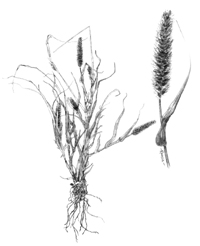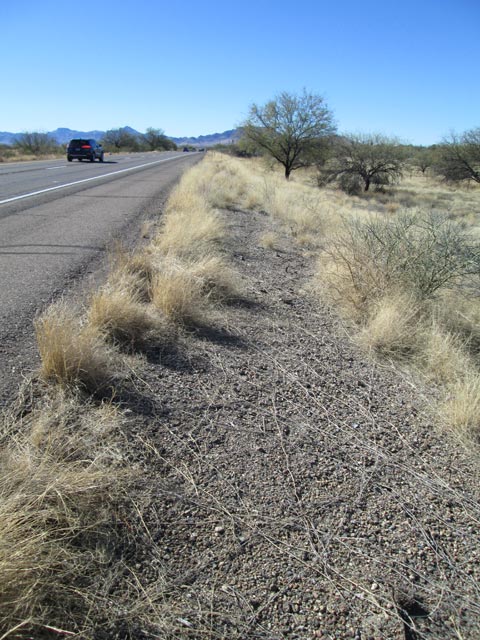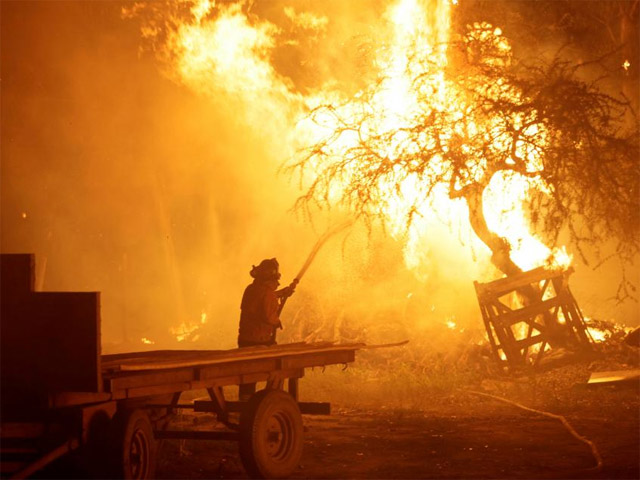
Buffelgrass is a recurring theme on this program and that is because it is really, really bad.
It was brought in by cattle ranchers from abroad in the 1930’s for cheap grazing because it is very low maintenance and reproduces easily. And it did. Now here’s a legal immigrant that is no longer welcome.
There is not enough cattle in Arizona and perhaps in all of the United States to keep it down. It is everywhere, on roadsides, on hill sides, in downtown alleyways. Dry like tinder throughout the year exept for a couple of weeks after the monsoon, it is a tremendous firehazard. More so, its seeds are fireproof, unlike those of most other plants in our area, so fire helps it to proliferate at the cost of the native vegetation, not least our beloved Saguaro. It sucks the nutrients and the water from the soil and threatens native species in that way as well. Those couple of weeks a year when it is green is the only time it is susceptible to herbicides. Otherwise, the only way to kill it is pulling it root and all and cover the pullings with plastic or rocks to keep the seeds from germinating.
It is a war of attrition – it takes about three years of diligent pulling in a particular location to make it dwindle away. In all likelihood, bunches of Buffelgrass are growing in your immediate area if not in your back yard. Pima County and the City of Tucson have issued ordinances obliging home owners to keep Buffelgrass and other invasive species, such as Fountaingrass, off their lot. That helps – a little. On the large scale, the motto is: If you find it, pull it.
The problem is that it looks a lot like a good many other grasses that are indigenous and should be left alone. So it is a good idea to participate in a couple of these organized pulls that have trained botanists along to point out the differences. Once you know what you’re looking for, you’re ready to go out on your own to rid your neigborhood of it and show your neighbors how to do it as well.

The reason to have cattle in the first place is that we like meat. The body coverts meat to energy much more efficiently than vegetable matter, so, although we can handle both, we prefer to have the hard work done for us by cows and pigs. And chickens. Regrettably, raising catlle produces far more CO2 and other green house gasses than plant crops. After a couple of centuries of increasing production, we are now living under a dome of these gasses which lets the sunlight in, but not out. Consequently the temperature under that dome is rising and that leads to all kinds of nasty stuff, such as major droughts. We are seeing some of that in our area and in California. Lake Meade, which is the mainstay of our water supply, is evaporating at a good clip.
But it could be worse. And in some parts of the world, it already is – in Chile for instance, where a prolonged drought combined with ill-advised forest management have led to uncontrollable forest fires, by far the biggest in the country’s history. Hundreds of thousands of acres have burned out, including the entire town of Santa Olga, leaving one dead and 6,000 fleeing for their lives. The US Embassy has pledged $100,000 to help out in the disaster, which to date has taken claimed at least 10 lives, several firefighters among them.
Sort of like Prescott, only bigger.

Januari 21 was Beat Back Buffelgrass Day and in spite of the rain, an amazing 150 volunteers showed up. But the inclement weather forced the postponement of work at several sites and volunteers are still very welcome for pulls on Februari 4 at Quail Canyon, February 11 at Catalina State Park, Feb. 15 at Avra Hill and Feb 18 at the Desert Museum. More information can be found at tucsoncleanandbeautiful.org.
If you find Buffelgrass outside city limits, please report it to the Pima County Department of Environmental Quality.

